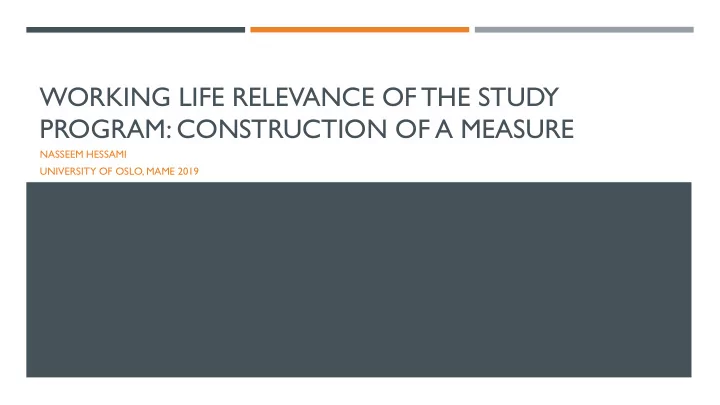

WORKING LIFE RELEVANCE OF THE STUDY PROGRAM: CONSTRUCTION OF A MEASURE NASSEEM HESSAMI UNIVERSITY OF OSLO, MAME 2019
CREATING THE WORKING LIFE RELEVANCE SCALE 2018 2019 Oct Nov Dec Jan Feb Mar Apr Stage I: Initial Instrument Development Stage II: Cognitive Interviews Stage III: Pilot Study and Data Analysis • NOKUT Expert Feedback Phase I: Phase II: Phase III: • Cognitive Interviews received and final 7 items Literature Search Revised Final Framework Peer and NOKUT conducted and selected for Pilot testing and cognitive + Initial Instructor Framework and Expert • assessed Pilot administered by 1 st draft items Review Review Instrument interview scale NOKUT Development development developed 16-item scale 12-item scale 7-item scale Pilot analysis
DISCLAIMER (ALREADY!): WLR AND THE SCALE’S OBJECTIVE Many iterations and rounds of expert / instructor feedback Extensive literature searches Lack of theory Lack of universal definition for WLR Scale Construction – The Substance: Working Life Relevance: Working Life Relevance in Norwegian Higher Education (Kantardjiev and Haakstad, 2015) Undergraduate business internships and career success: Are they related? (Gault, Reddington, and Schlager, 2000) Effects of career preparation experiences on the initial employment success of college graduates (Sagen, Dallam, and Laverty, 2000) Test Theory: Validating Interpretations and Uses of Test Scores (Kane, 2013)
FRAMEWORK AND CONSTRUCT MAP: WORKING LIFE RELEVANCE OF THE STUDY PROGRAM Students’ perceptions of the working life relevance of their study programs gauged by the extent to which students felt their programs exposed them to , and prepared them for , viable work opportunities. Working Life Relevance = Exposure Experiences + Preparation Experiences Likert Responses Agreeing with a statement to a low extent (1) or to a high extent (5)
STAGE II: COGNITIVE INTERVIEWS – 16-ITEM SCALE
STAGE II: COGNITIVE INTERVIEWS Cognitive Interview Respondent Profiles Gender Degree Yr of Study Institution Study Program Participant Male Master 5 th University of Bergen Law 1 Participant Male Master 2 nd BI, NMBU Property 2 Participant Female Bachelor 2 nd UiO Special Education 3 Participant Female Master 2 nd UiO Higher Education 4 Main Takeaways: No usage of the “I Don’t Know” response No two respondents found the same item confusing or unclear Respondents of different study disciplines seemed to have different views of WLR of their programs, reaffirming findings of Kantardjiev and Haakstad (2015)
THE 7-ITEM PILOT QUESTIONNAIRE
STAGE III: PILOT STUDY DATA – RESPONDENT PROFILES Study Pilot Respondent Profiles Proportion of Male: Female No. Programs No. Institutions Total responses 2nd year Bachelor 2nd year Master 5th year Master Respondents Represented Represented Item 1 703 346 293 64 0.37: 0.63 38 32 Item 2 703 346 293 64 0.37: 0.63 38 32 Item 3 678 334 280 64 0.36: 0.64 38 32 Item 4 709 346 299 64 0.37: 0.63 38 32 Item 5 690 336 290 64 0.37: 0.63 37 32 Item 6 612 303 248 61 0.37: 0.63 37 32 Item 7 648 318 266 64 0.36: 0.64 37 32
RESPONSE TRENDS OF PILOT STUDY Accounting for Missingness The (dangerous) MCAR Assumption Recoding “I Don’t Know” to N/A Descriptive Statistics for 722 Observations across 7 Items Listwise Deletion of Item Responses Mean SD Median Univariate ~N Missingness (MCAR)* Complete Missingness (N) response response I don’t know (6)* Unmarked (N/A)* (766 722 obs.) 1 703 3.59 1.19 4 No 19 0 Caution in drawing 2 703 3.17 1.34 3 No 19 0 conclusions from 3 678 3.46 1.22 4 No 44 3 ordinal data 4 709 3.82 1.03 4 No 13 2 5 690 2.84 1.32 3 No 32 1 6 612 2.67 1.34 3 No 110 1 7 648 2.79 1.30 3 No 74 3
UNIDIMENSIONALITY OF WLR & FACTOR ANALYSIS
IRT ANALYSIS: SCALE AND ITEM PRECISION Item Information Results Item 1 Item 2 Item 3 Item 4 Item 5 Item 6 Item 7 Peak 0.80 0.40 1.00 0.70 2.70 1.80 6.00 Information I( θ ) Latent -1.5 to 1 -2 to 2 -2 to 1 -3 to 1 -1 to 1 -2 to 1 -1 to 1 location of Peak Information: θ Overall Item Poor Poor Poor Poor Adequate Adequate Strong Contribution
DISCUSSION & LIMITATIONS Unidimensionality (or lack thereof) of the WLR Construct Descriptive Statistics for 722 Observations across 7 Items Inference-driven framework vs. theory- Item Responses Mean SD Median Univariate ~N Missingness (MCAR)* (N) response response driven framework I don’t know (6)* Unmarked (N/A)* Need for further validity studies, investigations, interviews, pilots 1 703 3.59 1.19 4 No 19 0 2 703 3.17 1.34 3 No 19 0 Different study programs = Different interpretations of WLR 3 678 3.46 1.22 4 No 44 3 4 709 3.82 1.03 4 No 13 2 Impossibility of a universal WLR definition 5 690 2.84 1.32 3 No 32 1 Items 5- 7 (“Exposure” Domain) not as 6 612 2.67 1.34 3 No 110 1 applicable and generalizable as initially 7 648 2.79 1.30 3 No 74 3 envisioned
FINAL SCALE RECOMMENDATION
QUESTIONS OR FEEDBACK?
REFERENCES
Recommend
More recommend